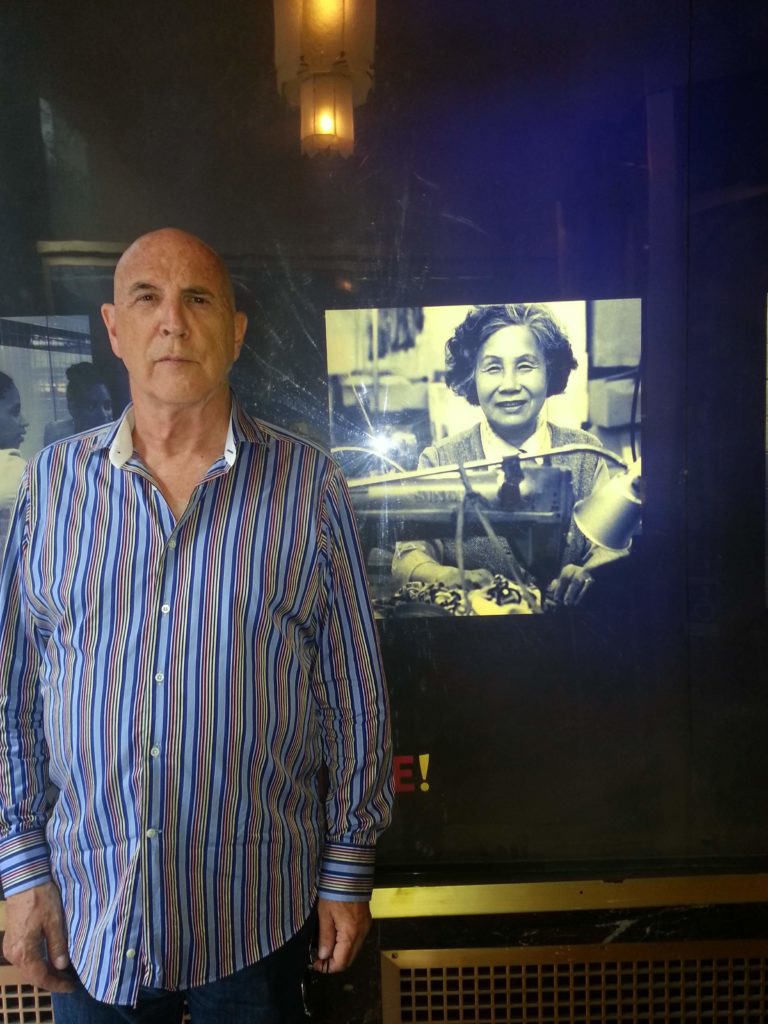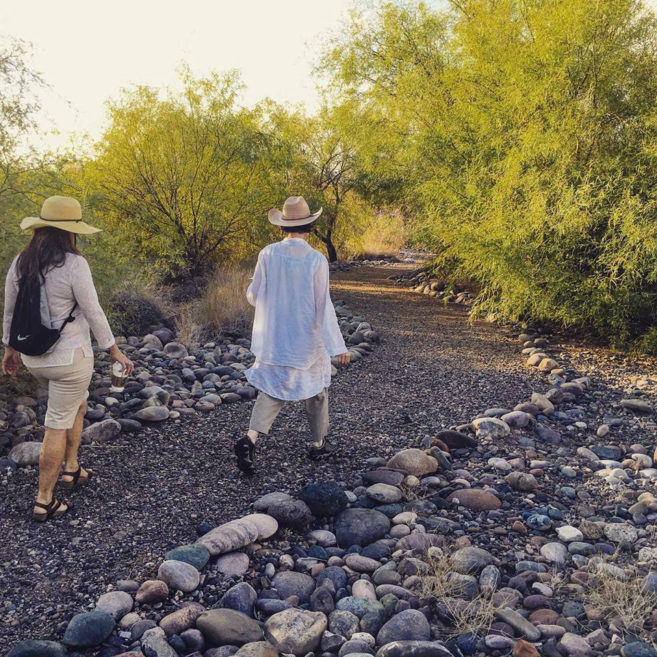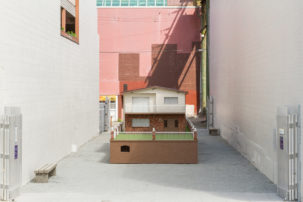On September 14, Canadian curator, writer and educator Bruce Ferguson passed away in Los Angeles. Ferguson’s influence was deep and wide-ranging, leaving an indelible mark not only on the practices of the artists he championed but also on the legacy of exhibition-making nationally and internationally. Here, some personal reflections on the life and work of a restless thinker whose curiosity, sensitivity and humour in many ways redefined what it means to see and understand contemporary art.
Most of us in Toronto last saw Bruce when he was invited to deliver a well-attended lecture at Hart House at the University of Toronto in April 2013. With a booming voice, great intelligence and his trademark sense of humour, he delivered a version of “Not in the Age of the Pharaohs,” a substantial talk rooted in his experience as dean of the School of Humanities and Social Sciences at the American University in Cairo, Egypt, which was first commissioned by Gerald McMaster for the 2012 Biennial of Sydney. With unique insight, he spoke to the period before and after the 18 days of revolution that took place there in 2011—exploring how contemporary artists in Cairo created art out of political tension without that tension becoming the manifest content of their work.
Celebrated as a curator, writer and teacher, Bruce co-edited, with Reesa Greenberg and Sandy Nairne, the pioneering 1996 anthology Thinking About Exhibitions—published after the three received a Getty Senior Research Fellowship grant in 1993 when there was not much literature about curating available. It came out just as I finished my MA on curating and was a book I often referred to.
I probably first met Bruce in the late 1980s. If not, I was certainly aware of him. He was making great exhibitions in the late 1970s—it might be truer to say I grew up on them. I am not sure how many of them I actually saw, but the catalogues were definitely building blocks in the foundation of my contemporary art education. While working as director of the Dalhousie Art Gallery he curated the first solo exhibition by artist Eric Fischl, whom he also befriended, in 1975. At that time Eric taught painting at the Nova Scotia College of Art and Design until he moved to New York in 1978. The group exhibition “Space Invaders,” co-curated with Nairne, opened at the MacKenzie Art Gallery in Regina in 1985, and focused on contemporary approaches to sculpture. It toured nationally, going to five provinces. Like many of Bruce’s group exhibitions, it included works by an international array of artists along with a few Canadians. He wanted to understand what it meant to be international and made it possible for many Canadian artists to be connected to a larger group of global peers. Bruce followed up with “The Impossible Self,” also curated with Nairne, which opened at the Winnipeg Art Gallery, where Bruce was working as adjunct curator, in 1988. In 1990 he co-curated “PASTFUTURETENSE” with Gary Dufour, for the Winnipeg Art Gallery and Vancouver Art Gallery and selected artists included Vikky Alexander, Ronald Jones, Klaus vom Bruch, David Diao and Jac Leirner, among others.
From the late 1980s onward, Bruce was recognized as an expert on cutting-edge Canadian art. He knew all the artists and got all the jobs—well, not quite—and was repeatedly invited to curate the Canadian contributions to the major biennials. Colin Campbell, Pierre Falardeau and Julien Poulin, General Idea, Tom Sherman and Lisa Steele were the Canadian video artists in his national pavilion exhibition “Canada Video” at the 39th Venice Biennale, in 1980. Kim Adams, Eleanor Bond, Roland Brener, Geneviève Cadieux, Wyn Geleynse and Barbara Steinman constituted his selection for “Northern Noises/Résonances boréales” at the 19th Sao Paulo International Biennale, in 1987. He also contributed to the Istanbul Biennial in 1992 and the Biennial of Sydney in 2010.
At a time when curators and institutions were still chasing down national narratives, he co-curated “Un-Natural Traces: Contemporary Art from Canada” with Carol Brown at the Barbican Art Gallery in London in 1991. This exhibition was one of a handful of surveys of contemporary Canadian art that made it across the ocean. As the edited list of names reveals, Bruce—like all who work in the profession—played favourites: Adams, Alexander and Bond appeared, along with Mowry Baden, David Buchan, Lynne Cohen, Robin Collyer, Angela Grauerholz, Micah Lexier, Jana Sterbak and Jeff Wall.
My strongest memories of Bruce are connected to the time I worked for him as an intern at SITE Santa Fe as part of my MA degree program from the Royal College of Art. He seemed to be having the time of his life, and curating, as far as I could tell then, was a glamorous profession. While I was in the back rooms typing up bios and various other tasks, he was on the floor with Vince Varga and the artists, installing what eventually became the monumental and provocative inaugural edition of this biennial, “Longing and Belonging: From the Faraway Nearby,” in 1995. This exhibition, with just over 30 artists, was global in scope and risk-taking in terms of media, focusing on the formation of identity. Marina Abramović, Francis Alÿs, Rebecca Belmore, Braco Dimitrijević, Gerald McMaster, Bruce Nauman, Alison Rossiter, Valeska Soares, Pierrick Sorin and Kara Walker all came to SITE to install their works. I remember Agnes Martin coming through early one morning.
I continued to work for Bruce as he conceptualized “Walking and Thinking and Walking” as part of “NowHere” in 1996 at Louisiana Museum of Modern Art in Humlebaek, Denmark. I recall him sharing his thoughts on curating at the time: he considered his skill akin to corralling and wrangling. Not surprisingly, he brought many of the SITE artists to Denmark, but his list also included a number of important Canadians, many of them by now his close friends. In the early days of the exhibition many people took note of Janet Cardiff’s experiential Louisiana Walk, and her international career was launched. This was an example of what Bruce did best.
The last time I saw Bruce was Christmas 2013. My husband and I prepared a meal for him and a few other friends. It was a great evening and Bruce was on form. At the time, he had recently left his position in Egypt to take up the post of vice chairman at Louise Blouin Media; not long after, he would be appointed president of the Otis College of Art and Design in Los Angeles, where he worked until he stepped down earlier this year. —Kitty Scott
Bruce and I first met in Halifax. It was 1974. He was director of the Dalhousie Art Gallery and I was teaching at NSCAD. We were babies making it up as we went along. We became fast friends; inseparable at times, insufferable at others. There was from the start an ease and fluidity with which we could enter each other’s imagined alternatives to whatever situation we found ourselves in. It was always playful, mischievous, vivid and inspired. Glee and laughter were what we were after.
Bruce championed my work very early on and found opportunities for me to push it further out into the larger world. He did this for many artists. It was his gift; a rare gift. He spotted and nurtured nascent talent and brought to their work a layered intelligence rooted in acute observation. It was never an intellectual overlay. The work spoke to him and he answered back with his impressive intelligence, insight and wit. He knew you don’t hit moving targets by aiming directly at them. He knew which angles of approach would cast the widest light on the object of his meditation.
I will not, in this small space, be able to list all that he did for me, for my work and for my career. Let me just say, in all sincerity, that were it not for him, I would not be where I am now. Or more simply put, were it not for him, I would still be where I was. A great man. A great friend. A great loss. —Eric Fischl
One of my dearest friends is gone. I first met Bruce one spring day in 1973 when I was travelling with the artist Sarain Stump. We made a detour to meet a Glenbow Museum curator about an exhibition. I sat quietly in the corner while they spoke, then we left. I never gave it much thought, until almost 20 years later, in 1991, when I was invited to a conference in São Paulo, Brazil, by Ivo Mesquita. I was among many of the delegates arriving via New York. As we piled into a charter bus, I was introduced to Bruce. I said to him, “I know you.” He said to me, “I know you too.” I was so surprised when he said that he’d been following my career. We immediately hit it off and our friendship lasted until his daughter texted me Saturday morning to say that he’d passed away peacefully. I just sat on my couch filled with emotion and began recounting the many years and stories we shared. —Gerald McMaster
How I met this quirkily intelligent, risk taking man: One day in the early 1990s Bruce, whom I barely knew, asked if I would look at a proposal that he and Sandy Nairne had put together for a grant from the Getty Foundation to study recent exhibitions. When I read it, my heart sank. There was no way any academic body would fund what they had proposed. Hesitantly, I put together a two-page, single-spaced, unsparing critique and sent it off. One week went by. Then, another. Towards the end of the third week Bruce called, thanked me, and asked me to join the project. That was the beginning of five years of close collaboration where time after time Bruce came up with the unexpected, turning the project in new, exciting, and right-on ways. RIP Bruce. —Reesa Greenberg
My journal records a first meeting with Bruce in Montreal on October 21, 1981. I instantly detected a kindred spirit, and when he and friends were driving that evening to Quebec City to see a performance by Tim Clark I accepted the invitation with alacrity. The journey took three hours and the performance just four minutes. I later recorded, “Talked to Bruce all the way back about museums and stuff…v. good.” So started a very special friendship of nearly 40 years and a sequence of collaborations, including co-curating “Space Invaders” at the MacKenzie Art Gallery in 1985 and “The Impossible Self” at the Winnipeg Art Gallery in 1988, conferences such as “The Politics of Images,” and culminating, with Reesa Greenberg, in compiling Thinking About Exhibitions, published in 1996.
Bruce offered me shared intellectual passions, sharp critiques of public institutions, and a constant desire to know what good artists and writers were up to, mixed with close family friendship. But whether as curator, critic, academic or educational director, Bruce Ferguson’s influence extends around the world. He will remain an inspirational figure. I miss him beyond words. —Sandy Nairne
Bruce Ferguson was an inspiring man, a bright and charming conversationalist, witty with a frank sense of humour, a generous mentor and a friend above all. I still remember when I first met him and Jon Tupper in 1986 at the São Paulo Biennial, where I was trained and was working at my first job as a curator. That professional encounter changed my life forever, for I came as curator-in-residence at the Winnipeg Art Gallery. A few years later, Bruce introduced me to the recently created (with his support and collaboration) Center for Curatorial Studies at Bard College in New York, where I taught for 11 years as a visiting professor. It was an honour and privilege to have known and worked with Bruce Ferguson. My deepest and proud appreciation, ever. —Ivo Mesquita
Though much of Bruce’s curatorial career was outside of the country I have always felt he was the best curator that Canada has ever produced. Not only was he able to organize many remarkable exhibitions and write engagingly brilliant essays, but he also took the time to be a mentor to many of us who had the privilege of working with him. Though I don’t want to in any way diminish his intellectual contribution to contemporary art I feel that he should be also acknowledged for his sense of style. Whether he was installing exhibitions or hosting an opening he did it with a unique sense of sartorial elegance. The first project we worked on together was the Canadian participation of the São Paulo Biennial. We had to do much of the installation ourselves and he would show up for work wearing a wonderful scarf, and it was to be the same scarf he wore at reception that opened the show. It looked perfectly suitable for each occasion—it wasn’t the scarf, it was the man wearing it. —Jon Tupper
The second time I met Bruce was outside the airport in Copenhagen in the spring of 1996. Bruce was wearing a long raincoat (so long that it made me think of the scene in Once Upon a Time in the West where these elegant outlaws are waiting for the train carrying Frank). He hugged me by surprise and asked me in a big smile: “Can you drive?”
Half an hour later I was driving a small VW throughout a desperately flat countryside while Bruce was sleeping in a sort of foetus mode on the back seat of our tiny car. Whenever we would stop for a beer, a smørrebrød and a coffee—always pretty much in that order—a flood of captivating ideas and considerations would come out of Bruce’s mouth. As soon as we’d get back in the car he would instantly fall back into deep sleep. I never knew what we were looking for, that is if we were looking for anything at all, but it’s one of the best road trips I ever took and it forged the base of deep trust and tacit understanding that seals my relation with Bruce. —Francis Alÿs
I met Bruce Ferguson in Santa Fe in 1995, when I was a 25-year-old upstart in a new art world. Bruce was funny, wry, smart and a real gentleman. I remember him going on about the way I drew and cut out my silhouette figures as I expanded the piece I was working on as part of his curation of SITE Santa Fe. His manner was so open, warm, gregarious. I felt in meeting him that we had always been friends, and his was the kind of friendship that seemed ever-present, somehow, despite time, distance, years.
Santa Fe was one of my first art-related trips and one evening Bruce and group of folks were driving in the desert to a collector’s house for dinner. I was wide-eyed with fascination at the landscape, a distant thunderstorm and the sunset. Bruce pointed a long arm out the window and told me, “That’s Bruce Nauman’s place”—somewhere out there, I couldn’t see anything but horizon. Anyway, in that same conversation he told me that the first time he met Mr. Nauman they discovered they had W middle names which aligned with pop culture’s other two famous Bruce’s: Bruce Willis and Bruce Wayne. From that point on I could never quite think of Bruce W. Ferguson without simultaneously conjuring the action-adventure movie star. Thanks to him I also think of Bruce Nauman as Batman. —Kara Walker
In 1996 on the recommendation of Kitty Scott, Bruce Ferguson took a chance on me with an invitation to make my first major audio walk at Louisiana Museum of Modern Art in Denmark. I can see in hindsight that this exhibition was a turning point for me as it led directly to international exposure that after a few more years led to a full-time career as an artist. At the time I was teaching in Lethbridge, which by another strange connection was where Bruce grew up.
I remember many dinners and drinks back then in Denmark and later brief connections throughout the years. He was great at telling stories of artists and horse riding, punctuated throughout with his deep gravelly voice and laugh. —Janet Cardiff
Bruce and I met after my panel at the “American Visions: Artistic and Cultural Identity in the Western Hemisphere” conference in São Paulo in 1991. He was all smiles, along with Gerald McMaster—the odd couple from Canada liked what they heard. We became friends for life. Bruce’s talk was titled “Who Speaks to Whom and For Whom and Under What Conditions.” A few weeks later, we started working together on the Istanbul Biennial. His generosity knew no bounds, for my friends and me. One of the biggest white men in the post-colonial times, he lived what he preached. Two years later, desperate to get a job, I met Bruce at a café around Chelsea in New York. He said he had the perfect job for me, lobbied for it, sat in my interview and stood firm behind me. I got the Center for Curatorial Studies position; my wife and I had a baby immediately after. The summer of 1994 we spent some days together at Miani’s modernist gem in the Hamptons. I was uncomfortable with my swimming shorts and said I did not want to swim. Bruce pulled up his T-shirt and squeezed his giant belly to make it speak. —Vasif Kortun
My friendship with Bruce began over 40 years ago. He was the director of the Dalhousie Art Gallery and I was a student at NSCAD. We worked together on many exhibitions over the years. But our first project was a show called “Appearing” at Mount Saint Vincent University in Halifax in 1983. It was a group show featuring myself, April Gornik, Anne Ramsden, Joyan Saunders, Martha Townsend, Carol Wainio and Wendy Wortsman.
I have just re-read Bruce’s catalogue essay for the exhibit. While it mentions that all of us had studied at NSCAD, the fact that we are all women is never brought up. We were artists. THE END. In 1983 I was a young artist, living and working in New York. I was just getting my feet wet. I didn’t realize how unusual it was for a curator to let work stand on its own.
Bruce’s curating never conformed to the obvious and in many respects, he was ahead of his time in what he chose to champion. He was always a charming, humorous, self-effacing initiator and innovator and connector. He is missed. —Vikky Alexander
I never knew Bruce Ferguson in Canada. I only spent time with him in Chicago, Phoenix and New York. During our encounters we always talked about what it meant to be Canadian. Despite numerous conversations by email and a few times by telephone, the last time that I saw Bruce in person was in New York in 2013. I had just completed my first year teaching at the University of Pennsylvania in Philadelphia, after moving from Vancouver. Bruce and I spent the afternoon walking around midtown. It felt as though we were two exiles on a stroll in a foreign land (which I guess we were). We talked about art and life. At one point we found ourselves near the Unite Here! headquarters. I told him that a photograph of my grandmother working in a sweatshop adorned the union headquarters foyer, a story I also recounted in a piece I wrote for Canadian Art. He insisted that we see it. After looking at the photograph for some time, Bruce asked me all sorts of questions about my grandmother. He genuinely wanted to know more about her. At some point, I found it too emotional to answer. Bruce stopped asking me questions and then put his arm around me. He offered words of understanding and I immediately felt better. He suggested that we go for a beer at a nearby tavern where we talked for another two hours before I had to catch my Amtrak train home. The last time I spoke to him, he was about to head off to Otis College of Art and Design in Los Angeles. I said to him how much I looked forward to seeing him next, another stroll through Manhattan perhaps. But our paths failed to align. I will always remember Bruce as a person of tremendous compassion towards others and curiosity about the world. —Ken Lum
 Bruce Ferguson in front of a photo of Ken Lum's grandmother at the Unite Here! headquarters in New York, 2013. Photo: Ken Lum.
Bruce Ferguson in front of a photo of Ken Lum's grandmother at the Unite Here! headquarters in New York, 2013. Photo: Ken Lum.






